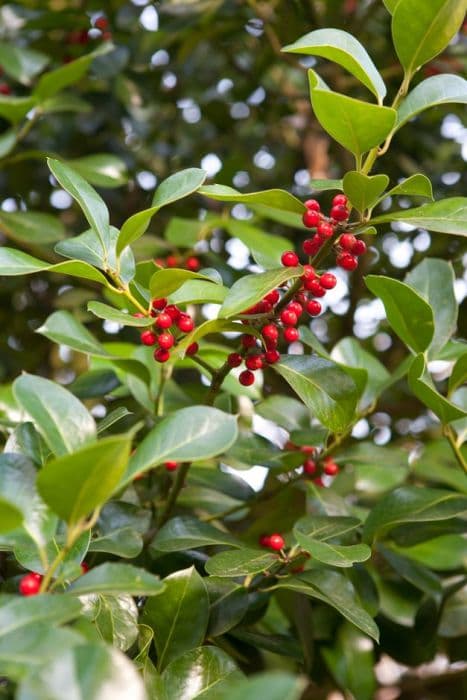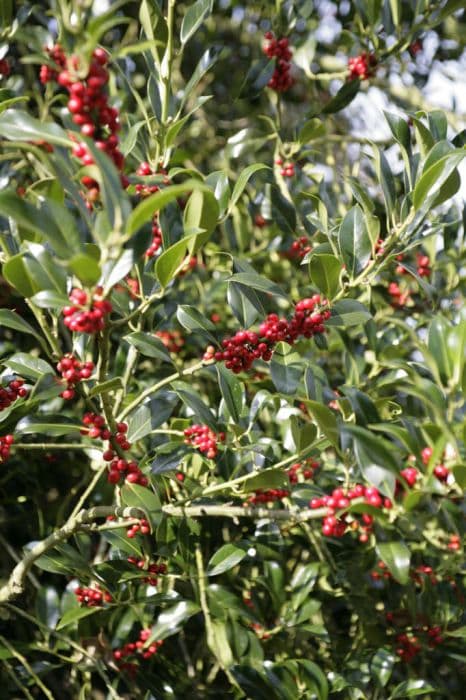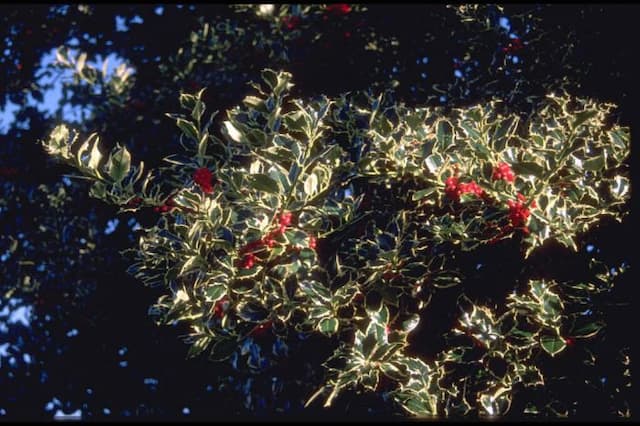Highclere Holly Ilex × altaclerensis 'Camelliifolia' (f)

ABOUT
Highclere Holly 'Camelliifolia' is a striking, evergreen shrub that is well-known for its glossy, dark green leaves. The leaves exhibit a similar shape to those of a camellia, with a smooth texture and a slightly wavy edge that provides a unique visual appeal. The foliage may also have spiny margins, depending on the individual plant, which adds to the textured look of the shrub. During the spring season, Highclere Holly 'Camelliifolia' produces small, white flowers that contrast beautifully against the dark foliage. Later in the year, red berries may appear. These berries are often very attractive to birds and other wildlife, adding a further point of interest to the plant. Highclere Holly 'Camelliifolia' has a dense growth habit, forming a thick, bushy appearance which makes it ideal for use in hedges and privacy screens. The juxtaposition of the shiny leaves and the often colorful berries creates an elegant display that is visually pleasing throughout the year. The overall impression of the plant is one of robustness and classic beauty, with its traditional holly characteristics and camellia-like leaves setting it apart from other garden shrubs.
About this plant
 Names
NamesFamily
Aquifoliaceae
Synonyms
Highclere Holly
Common names
Ilex × altaclerensis 'Camelliifolia' (f).
 Toxicity
ToxicityTo humans
The most common common name for Ilex × altaclerensis 'Camelliifolia' is Highclere holly. Highclere holly is considered toxic to humans if ingested. It contains saponins and alkaloids, especially in the berries, which can cause symptoms such as nausea, vomiting, diarrhea, and abdominal pain. In severe cases, particularly with large quantities ingested, it may result in more serious symptoms like drowsiness, dehydration, and electrolyte imbalance. The leaves may also be toxic but are less commonly ingested due to their prickly nature.
To pets
Highclere holly is toxic to pets if ingested. The berries contain substances such as saponins and alkaloids which can cause symptoms that include vomiting, diarrhea, abdominal pain, and drooling in pets. More severe cases could lead to dehydration, drowsiness, and a loss of appetite. The leaves, due to their spiky texture, are less frequently eaten by pets, but they can still cause gastrointestinal upset if ingested. Pet owners should prevent their animals from having access to Highclere holly to avoid accidental poisoning.
 Characteristics
CharacteristicsLife cycle
Perennials
Foliage type
Evergreen
Color of leaves
Green
Flower color
White
Height
8 feet (2.44 meters)
Spread
5 feet (1.52 meters)
Plant type
Shrub
Hardiness zones
6
Native area
Hybrid
Benefits
 General Benefits
General Benefits- Attractive Foliage: Ilex × altaclerensis 'Camelliifolia' has glossy, dark green leaves that provide year-round visual interest.
- Durability: This plant is known for its hardiness and can withstand harsh weather conditions once established.
- Ease of Maintenance: It requires minimal care compared to more delicate plants, making it suitable for low-maintenance gardens.
- Privacy Screen: Due to its dense growth habit, it can be used to create privacy screens or hedges in landscapes.
- Bird-Friendly: The plant can produce berries that provide food for birds, encouraging wildlife in the garden.
- Versatility: It can be trained into various shapes and sizes, which makes it a versatile choice for different landscape designs.
- Seasonal Interest: While primarily an evergreen shrub, it may produce white flowers in spring, adding seasonal appeal to the garden.
 Medical Properties
Medical PropertiesThis plant is not used for medical purposes.
 Air-purifying Qualities
Air-purifying QualitiesThis plant is not specifically known for air purifying qualities.
 Other Uses
Other Uses- Topiary Art: Highclare holly can be pruned and shaped into formal topiary designs, allowing gardeners to create living sculptures in their landscapes.
- Festive Decorations: Branches of Highclare holly with their glossy leaves and sometimes berries are used in wreaths and other holiday decorations, particularly during Christmas.
- Hedge Screens: Due to its dense growth, Highclare holly is often used to form privacy screens or hedges in gardens and parks.
- Wildlife Shelter: The dense foliage provides excellent shelter for birds and other wildlife, offering a safe haven from predators and harsh weather.
- Photography Backgrounds: The plant's aesthetic appearance makes it a popular backdrop for photographers, particularly in garden settings.
- Urban Landscaping: This holly variety is useful in urban environments for its pollution tolerance and ability to thrive in confined soil spaces.
- Soil Erosion Control: Highclare holly can stabilize soil on slopes due to its root system, reducing soil erosion in vulnerable areas.
- Sound Barrier: When planted in rows, Highclare holly can help reduce noise pollution by acting as a natural sound barrier.
- Windbreaks: Because of its sturdy nature, it can be used in coastal and windy areas to protect gardens from strong winds.
- Educational Tool: Gardening enthusiasts and educational institutions use Highclare holly to teach pruning and garden design techniques.
Interesting Facts
 Feng Shui
Feng ShuiThe Highclere holly is not used in Feng Shui practice.
 Zodiac Sign Compitability
Zodiac Sign CompitabilityThe Highclere holly is not used in astrology practice.
 Plant Symbolism
Plant Symbolism- Protection: The Ilex, or holly, is often considered a symbol of protection due to its spiky leaves, which were believed to ward off negative energy and malevolent entities.
- Hope: Holly plants, with their evergreen nature, symbolize hope and eternal life, as they remain vibrant and alive even in the harsh winter months.
- Festivity: Associated with Christmas, holly is symbolic of joy and celebration during the holiday season.
- Good Fortune: In some cultures, holly is believed to bring good luck and is often used in decorations for this reason.
 Water
WaterThe Highclere Holly should be watered thoroughly, allowing the soil to be moist but not waterlogged. During the growing season, water the plant once a week with about 1 to 2 gallons, depending on the size and the weather conditions. In hot, dry spells, you may need to water twice a week, whereas in cooler, wetter conditions, less frequent watering may suffice. During the winter, reduce watering to every two to three weeks, or as necessary to prevent the soil from completely drying out. It is crucial to ensure good drainage to avoid root rot.
 Light
LightHighclere Holly thrives in partial shade to full sun. It is best situated in a location where it can receive morning sunlight and partial shade in the afternoon to protect it from the intense heat of the day. However, the plant is adaptable and can also do well in a spot that receives sun most of the day if it is not excessively hot. Avoid deep shade as this can lead to poor growth and fewer leaves.
 Temperature
TemperatureThe Highclere Holly can tolerate a range of temperatures and is relatively hardy. It can survive in temperatures as low as 5°F and as high as 90°F. However, the ideal temperature range for this holly is between 30°F and 70°F. Providing mulch around the base can help protect the roots in colder temperatures and keep the soil cooler in hot conditions.
 Pruning
PruningPrune Highclere Holly to maintain its shape and encourage bushier growth. The best time for pruning is late winter or early spring before the onset of new growth. It can also be pruned again in mid-summer if necessary. Pruning may be done annually, but heavy pruning should only be performed every few years to prevent stress on the plant.
 Cleaning
CleaningAs needed
 Soil
SoilThe Highclere holly prefers moist, well-draining soil with a slightly acidic to neutral pH ranging from 6.0 to 7.0. A soil mix of equal parts loam, peat, and well-rotted compost would be ideal, ensuring good drainage while retaining adequate moisture.
 Repotting
RepottingHighclere holly should be repotted every 2 to 3 years in the spring. However, mature plants can be repotted less frequently, every 3 to 5 years as they prefer not to be disturbed too often.
 Humidity & Misting
Humidity & MistingHighclere holly tolerates a range of humidity levels but prefers consistent moderate humidity. Avoid placing in extremely dry conditions; normal room humidity is usually adequate.
 Suitable locations
Suitable locationsIndoor
Ensure bright, indirect light and cool temperatures indoors.
Outdoor
Plant in partial shade; shelter from harsh winds.
Hardiness zone
6-9 USDA
 Life cycle
Life cycleHighclere holly, the common name for Ilex × altaclerensis 'Camelliifolia' (f), begins its life cycle when seeds germinate, typically in spring. Seedlings establish themselves, developing root systems and foliage as they grow into young plants. This stage can take several years, during which the plant will develop a strong structural form. As it matures, Highclere holly reaches the reproductive stage, producing small white flowers that are attractive to pollinators. After pollination, these flowers develop into the typical red holly berries, which persist through the winter and can contribute to the spread of the plant when birds disperse the seeds. Eventually, the holly may reach the end of its life cycle, which can be many decades, at which point it will senesce and die, completing the cycle.
 Propogation
PropogationPropogation time
Spring to early summer
Ilex × altaclerensis 'Camelliifolia', commonly known as Highclere Holly, is most effectively propagated through semi-hardwood cuttings. The ideal time for taking cuttings is during the late summer to early fall. To propagate, cut a 4 to 6-inch (10 to 15 cm) length of stem with several leaves attached from the current year's growth. The bottom of the cutting should be snipped just below a leaf node, and the lower leaves should be removed. Then, dip the base of the cutting in rooting hormone to encourage root development. Place the cutting in a pot filled with a mixture of peat and perlite and keep it moist but not waterlogged. Providing a humid environment by covering the pot with a plastic bag can help ensure success. The cutting should root in several weeks, after which it can be transferred to a larger pot or its final location.









